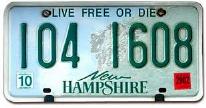 When I was a child, cars didn't have seatbelts. Passengers were just loose in both the front and back seats. For that matter, in family sedans (as opposed to sports cars), the front seat was generally a "bench" seat, holding three people. Although old cars lacked many of the features of more modern ones, they usually did seat six. Modern cars typically have two bucket seats in front, and only seat five overall. This is rather a loss, because two cars are usually needed to carry three couples. I think this is a result of cars becoming, in general, a bit smaller, and hence a bit narrower. In those days, when you passed a serious accident on the side of the road, you usually saw a circular shattered area on the windshield, where it had been hit by a passenger's head, hard enough to break the glass. Such accidents produced extremely serious brain injuries, and very frequently death. In fact, the right front passenger seat was referred to as the "death seat". This sort of damage is less commonly seen in accidents these days, now that all cars have seatbelts, and the majority of drivers and passengers wear them. Click the next link for information on seatbelts from the Insurance Institute for Highway Safety.
Someone once told me that he didn't wear a seatbelt because his chance of getting into an accident in any given trip by car was very small, and reducing that risk was not worth the aggravation of putting on his seatbelt every time he drove. His logic was obviously faulty. He was comparing the probability of getting into an accident on one trip with the aggravation of bucking up his seatbelt on every trip during a lifetime of driving. To make a proper cost-benefit analysis, he had to do one of two things. Either had to compare the probability of getting into an accident on a single trip with the extremely small aggravation of buckling his seatbelt exactly once, or he had to compare the chance of being saved from a serious injury or death over a lifetime of driving with the aggravation of buckling his seatbelt every time he drove. But I would argue that buckling your seatbelt is not an inconvenience at all. I was once asked to move my car in a parking lot, to make room for another car providing a jump start. I got into my car, and drove it forward across the parking lot aisle and into another space directly ahead. When I finished doing this, I found the friend whom I had been with laughing at me. He said, "Did you think you were going to get into an accident while moving your car forward one space?". I still didn't understand what he thought was so funny, and I asked what he meant. "Well," he said, "you buckled your seatbelt in order to drive your car forward about 50 feet." I had to laugh at that myself. But the fact is, buckling my seatbelt whenever I get into a car is completely automatic. I do it, obviously, without even giving it a second thought. I would maintain that once that operation becomes completely habitual, it really isn't any inconvenience at all. So by using my seatbelt routinely, I can approximately halve my risk of serious injury or death in a car accident, and as far as I'm concerned this costs me nothing whatsoever. In my blog entry on electronic design legend Bob Pease, I noted that I had once speculated to Bob about why a great many drivers donít wear seat belts. I suggested that perhaps people donít like to have to be reminded, every time they get into a car, that driving is one of the most dangerous things we do regularly in our everyday lives. Rather to my surprise, Bob wrote back that he didnít think that driving was dangerous. I let his remark slide, and didn't further pursue the issue with him. Most engineers are fairly safety conscious, but I was surprised that Bob drove an ancient 1969 Volkswagen beetle on California roads. And in June of 2011, Bob was killed in a single car accident in which he hit a tree. He was not wearing a seatbelt at the time, although his wife reported that he usually did wear one. Was there some denial apparent in Bob's attitude? I have no way of knowing. In a comment in the EE Times report on Bob's death, Rajat Sewal, concerned about Bob's old beetle not being a safe car to drive, actually asked him, "What if you hit a tree?" Bob replied, "I don't plan to". As I noted in a footnote to that blog entry, I wasn't trying to say to Bob that driving is extremely dangerous. I just meant exactly what I said, that it's one of the most dangerous things we do in our everyday lives, partly because we do so much of it. While your chance of getting into a serious accident is pretty low on any single drive, we can easily drive four or more times a day, adding up to more than 85,000 trips in a car in a sixty-year driving career. How many people can say they've never been in an automobile accident? How many have never personally known someone who was seriously injured or died in an automobile accident? That gives you some idea of the cumulative risk of driving over a lifetime. I've been in a reasonably serious frontal collision, and so have both of my daughters. None of us were injured (other than minor bruises), because we were wearing our seatbelts. Of course, all these personal experiences are irrelevant in comparison to actual scientific studies of the effectiveness of seatbelts, and the results of these studies are quite clear. Seatbelts definitely do save lives. I mention this point because many people give far too much credence to personal experience, which is really a very bad way of obtaining reliable knowledge. As the brilliant physicist Richard Feynman once said, "Science is a way of not fooling yourself, and you are the easiest person to fool." There are occasionally accidents in which a driver or passenger is saved by being thrown free of the car, and might have been killed or seriously injured had he or she been trapped in a seatbelt. When a person has had such an accident, or knows someone who has had such an accident, they will frequently never wear a seatbelt again. But that's a bad decision. Such accidents are rare, and when a driver or passenger is thrown out of a car during an accident, the event is most often fatal. A driver who survives such an accident without a seatbelt has simply had a lucky good outcome after making a bad decision. Note 2 I'll close, nevertheless, by mentioning one personal experience that I did learn from. For some reason I was driving a borrowed car, and as always I snapped myself into my seatbelt. Upon arriving at my destination, I found myself unable to get out of the belt. Neither side of the belt appeared to lift, which is the usual mechanism for opening a buckle. Nothing was written on the belt by way of instruction, and there seemed to be no visible levers or knobs or buttons. It took me a minute or so to realize that this particular belt was opened by pushing on the car manufacturer's logo in the center of the buckle. It was a hidden button. In this instance, as is generally the case, I had no need to get out of the car quickly. But since this event, whenever I get into a car that I'm not familiar with, after locking my seatbelt, I make sure I know how to open it.
  Note 1:
But in May of 2003, the structure completely collapsed. Maybe God was angry about New Hampshire's lack of a seatbelt law. The state is in the process of designing a memorial. [return to text] Note 2:
The important distinction between a good or bad decision versus a good or bad outcome was discussed in my blog entry entitled "The gambler". [return to text]
 |

 The "Old Man of the Mountain" was a natural rock structure near Franconia, New Hampshire, visible from the main highway. It was (and perhaps still is) the emblem of the state of New Hampshire, and it is the silhouette seen in the center of the New Hampshire license plate shown near the beginning of this entry. The same silhouette also appears on state route number signs, surrounding the number, or as an outline.
The "Old Man of the Mountain" was a natural rock structure near Franconia, New Hampshire, visible from the main highway. It was (and perhaps still is) the emblem of the state of New Hampshire, and it is the silhouette seen in the center of the New Hampshire license plate shown near the beginning of this entry. The same silhouette also appears on state route number signs, surrounding the number, or as an outline.